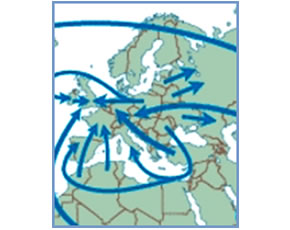
Both genetic and environmental risk factors have been established for a number of rheumatic diseases. However, sorting out the dominant mechanisms of risk (genetic or environmental) is difficult in static populations. The study of immigrant populations allows some distinction of genetic vs. environmental influences on disease risk, since genetic risk will tend to predominate in first generation immigrants, while environmental risks will manifest in later generations. Here, Li et al (Arthritis Rheum 2009; 60(6); 1588) explore the incidence of rheumatoid arthritis, ankylosing spondylitis, lupus, and scleroderma among immigrants to Sweden compared to the native Swedish population.
Methods
The Swedish national “MigMed” database was interrogated for data on the first hospitalization for individuals coded as rheumatoid arthritis, ankylosing spondylitis, lupus, and scleroderma. Recent immigrants and their second-generation offspring were classified according to their country/region of origin and incidence rates compared to those of native Swedes. The calculated standardized incidence rates (SIRs) were adjusted for gender, age, geographic region, socioeconomic status, and period of diagnosis.
Results
Compared to native Swedes, adjusted SIRs for any rheumatic disease were significantly higher in first generation immigrants from Finland (SIR 1.12 95%CI 1.15-1.26) and Iraq (SIR 1.61 95%CI 1.19-2.13). These differences were retained in the offspring of first-generation immigrants from Finland and Iraq. SIRs for any rheumatic disease were significantly lower in first generation immigrants from Denmark, Greece, Italy, Germany, Austria, Yugoslavia, Estonia, Poland, Hungary, and Turkey. These differences were no longer observed in the off-spring of first generation immigrants. Overall, the adjusted SIR for any rheumatic disease was lower in first generation immigrants compared to the native Swedish population (SIR 0.96 95% CI 0.93-0.98), a difference that was no longer significant in the offspring of first generation immigrants (SIR 0.97 95% CI 0.93-1.02).
For rheumatoid arthritis, the rate of first hospitalization for rheumatoid arthritis was significantly higher for first-generation immigrants from Finland and Iraq; however, these differences remained significant only for the offspring of first generation immigrants from Iraq. Lower rates of rheumatoid arthritis observed in first generation immigrants from several European countries were lost in the offspring of these immigrants, with the exception of the offspring of immigrants from Germany and Austria who retained lower rates of rheumatoid arthritis into the second generation compared to native Swedes.
For ankylosing spondylitis, adjusted rates of first hospitalization for the disease were increased in first generation immigrants from Finland and Norway, and decreased in immigrants from The Netherlands, and the United Kingdom, compared to native Swedes. In the second generation, higher rates of ankylosing spondylitis relative to the native Swedish population were still observed in the offspring of immigrants from Finland and Norway; however, rates in the offspring of immigrants from the Netherlands and the United Kingdom were equivalent to those of native Swedes.
For lupus, first generation immigrants from Africa, Latin America, Iran and Iraq demonstrated higher adjusted rates of incident disease compared to native Swedes. These higher rates were retained in the offspring of first generation immigrants from Africa and Iraq. Lower rates of lupus compared to native Swedes observed in first generation immigrants from Germany and Turkey were not significantly lower in the offspring of these immigrants.
For scleroderma, higher relative rates in first generation Hungarian immigrants, and lower rates in first generation immigrants from Denmark were no longer significant in the offspring of these immigrants.
Conclusions
Several first generation immigrant groups have differing rates of incident rheumatic disease compared to the native population. In a few cases, these differences persisted into the second generation of immigrants, suggesting a strong genetic risk in these populations. However, in many cases, differences in disease risk compared to the native Swedish population were lost in the offspring of immigrants, suggesting that environmental factors also influence the risk of developing rheumatic disease.
Editorial Comment
This is the largest migrant study of rheumatic disease to date. Although it is not immune to the usual criticisms of this type of study (e.g. a lack of specific genealogic information, unclear data on the degree of retention of cultural practices (i.e. diet and traditional medicines) in immigrants, and the potential for selection bias based on socioeconomic status and heath care utilization among immigrants), the study does provide some clues into the relative contribution of genetics and environment into the risk of the rheumatic diseases studied. For the rheumatic diseases with the strongest genetic basis (i.e. rheumatoid arthritis and lupus), risk was retained even into the second generation immigrants, while scleroderma, the rheumatic disease postulated to have the strongest environmental basis, showed no retention of risk into the second generation. Perhaps most interesting, many of the populations with lower disease risk lost protection in the second generation, suggesting that protection for rheumatic disease resides more in environment factors than in specific genetic protective mechanisms. Understanding these environmental protective factors may help to reduce the development of rheumatic disease, even in higher risk populations.

